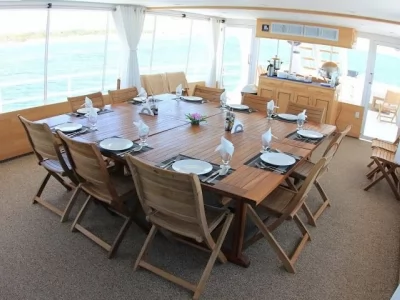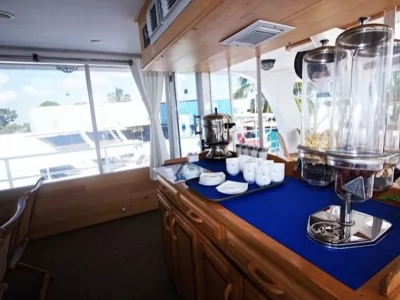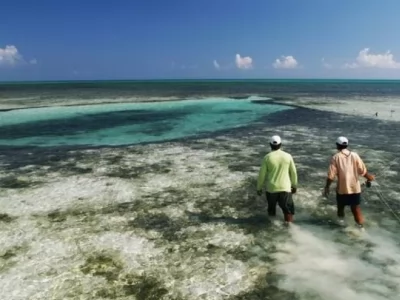Gear and Equipment
Rods:
One Bonefish rod, a 9-foot rod for #7,8 or 9 weight line, we suggest Cortland Precision XC 4 PC 9 feet 8 W/Fighting butt. An 8-weight rod is perfect as many of the bones are in the 3-6 lb. class and there is a lot of wind to contend with. On this rod you will want a good bonefish reel with enough capacity for the line and 200 yards of 20 lb backing. You need only a floating line, we advice the new Cortland Precision Tropic Plus Bonefish 90ft WF8F. Be sure to bring a back up floating line for bonefish. There is some coral on the Ocean side flats, and many flats have small mangrove roots and shoots that the bonefish run through and around and this can shred a fly line.
Bring one back up rod for bonefish in case of breakage.
Two - 9’ #10 Rods, we suggest – since there are so many species of fish in the JDR, it helps to bring two 10 weight rods.
Then you can set one up specifically for permit, and have another set up for baby tarpon or Barracuda. Have individual reels for both these rods. You will want WF-10-F lines for both rods, but it is a good idea to bring one slow sinking line also.
Attach your lines to backing with loop-to-loop connections making it easy to change lines out on the flats. Your 10 weight reels should have capacity for the line plus 150-200 yd. of 30 lb. backing. Our favorite reels are the Cortland Turbine Reel LA-789, or the Precision XC Large Arbor # 3 which has good backing capacity and a strong, smooth drag.
One - 9 foot #11 or 12 line rod for big tarpon, especially in the months of May through July when larger tarpon are present. Our favorite rods are the Loomis CrossCurrent GLX in 9 foot #11 and the Sage Xi2 in the 9 foot #11. For a less expensive rod the Redington CPS or the Temple Fork TiCr-X are good choices.
Reels:
For reels, pick a good tarpon reel with enough capacity for a 12 line and 150-200 yards of 30 lb. backing. A strong, smooth drag is necessary. We recommend the Cortland Embassy 60 or the Precision XC Large Arbor # 4.
Lines:
Free tarpon lines on your big rod, you will want four different lines. A floating line, like the Precision Tropic Plus Tarpon Ghost – Tip 90ft WF11F, an intermediate (slow sink), the same model of the Cortland floating line is also available on Intermediate, and then a fast sinking head like the RIO DC-400 for the big channels which are up to 15 feet deep with strong tidal currents. All should have loop-to-loop connections to your backing. Less experienced casters will often do better with a floating line but the Slow Sinking line is perhaps the best all around line to use in the deeper channels. Out on the shallower flats, a floating line is a much better choice. In addition, is recommendable to bring a 400 grains sinking line, very useful when looking for big tarpons on deep channels.
6 Bonefish leaders -12 foot 1X or 14 lb.
2 Spools of bonefish tippet, 1X and 01X Fluorocarbon. Most of the time the bonefish are not at all leader shy so it is an advantage to use heavier tippet. Also, in the JDR it is always possible to see and hook really big bones in the 9-12 lb. class.
The heavier tippets will allow you to land many more fish and handle them more easily when releasing them.
6 - Permit Leaders 9-12 foot, 16-20 lb. fluorocarbon tippets.
1 - Spool 02X (20 lb.) Fluorocarbon tippet for permit
6-10 - Quick Change Tarpon leaders. OUR GUIDES ALWAYS RECCOMMEND TO MAKE YOUR LEADERS WITH A 60 LB FLUOROCARBON SHOCK TIPPET AND THEN A SECTION OF 80 LB FLUOROCARBON TIPPET, WHERE YOU WILL TIE THE FLY.
Some anglers prefer to use 3 feet of shock tippet so that you can use each leader for several fish or re-tie on several different flies.
Note: You can use a 40lb - 60 lb. shock tippet for the baby tarpon that are under 40 lb. but for the larger fish, go up to 80 lb or they may cut or abrade through the 60 lb, sometimes, a 100lb fluorocarbon tippet will be useful too, so we recommend to bring some meters on this too.
If you are looking a Tarpon record, bimini leaders must be used, this starts with a 60lb section, then a 20lb fluorocarbon tippet, finally an 80lb.
1 - 200 yd. spool of extra 30 lb. fly line backing
1 - tarpon fly stretcher or Zip lock bags for your tarpon flies on Leaders
Spinning fishing equipment:
Multifilament 80 to 120 lb (light fishing) and 50 to 60 lb (light fishing)
Carabiners in all sizes.
Rods powerful tip action between 2,00 mts and 2.1 mts preferably Shimano G’Loomis
Lures, light fishing
Yusuri
Magnum until # 14 (plastic fin)
Sufeebull (150 grs. and 220 grs.)
Hidropensi (all sizes)
Stick bee (all sizes)
Feather Jigs (from 10 grs. up to 200 grs.)
Squid imitation (leaded and pallet)
Bonefish Flies:
Bring two to three dozen bonefish flies in various patterns for a week of fishing. You need a mix of very light flies and medium weight flies (with bead chain eyes) to fish in water depths from six inches to two feet. You’ll also need at least a half dozen flies with heavy lead eyes for fishing bones in muds where the water can be 3-4 feet deep. Some of the best patterns are the Tan and Pearl Shrimp, Borski Bonefish Slider, the Kwans, and of course the Crazy Charlie style flies. Pearl Gotcha patterns are also very good. Sizes should be mostly #6’s with a few #4’s and a few smaller #8’s. The bonefish can be selective, so be sure to experiment with various patterns. Most flies should be darker patterns – tan and brown but you also need some very light or white patterns for white sand flats.
Permit flies:
Bring 6-12 flies for permit; avalon permit fly will be a very good option, smaller permit crabs are also ideal for big bonefish. Some of the most effective crab patterns here are the Enrico Puglisi Palometa crabs in Tan and Beige (1/0 and 2) and the Anderson McCrab in size 2. Mantis Shrimp patterns are also quite good, especially when you encounter schools of “floaters”. These should be tied in size 2-4, and light colors mostly white, light tan and olive.
Tarpon flies:
Keys style patterns in size 2/0 are very good on the flats for tarpon in the 15-50 lb. class. The best patterns are the Orange/Yellow/Grizzly, Brown Cockroach, Black Death and a White/Grizzly Cockroach Deceiver. Some of the new Enrico Puglisi patterns have proven to be deadly too, especially the Black and Purple “Peanutbutter” in both 2/0 and 3/0, do not forget to bring the FFTRun Toad in 3/0. Other good Enrico patterns are his White/Yellow, and the Backcountry brown as well as the brown and orange. If you are tying your own, tie all these tarpon flies on the Gamakatsu SC-15 hooks, in either 2/0 or 3/0.












































